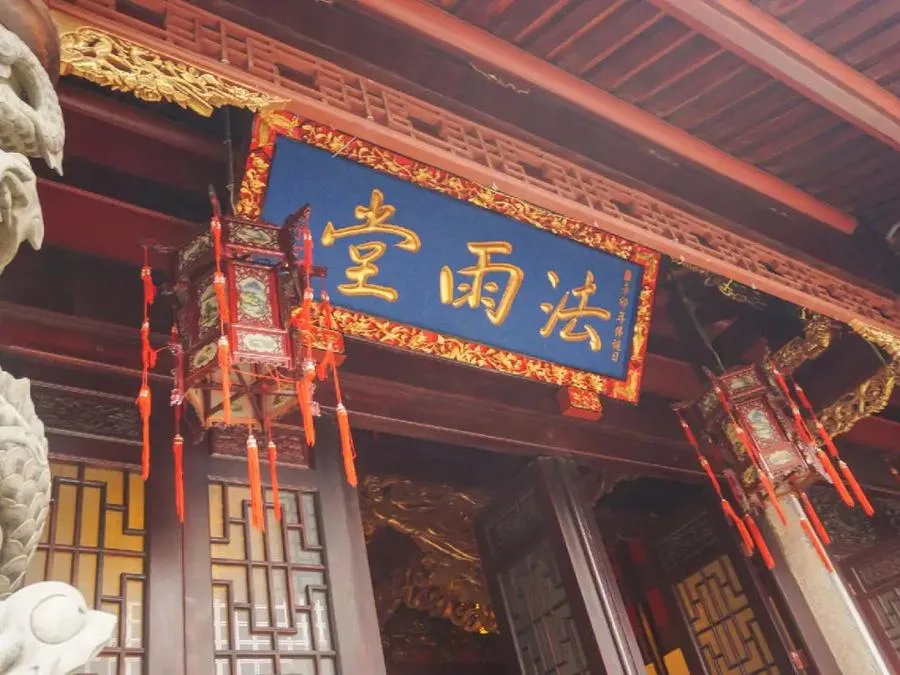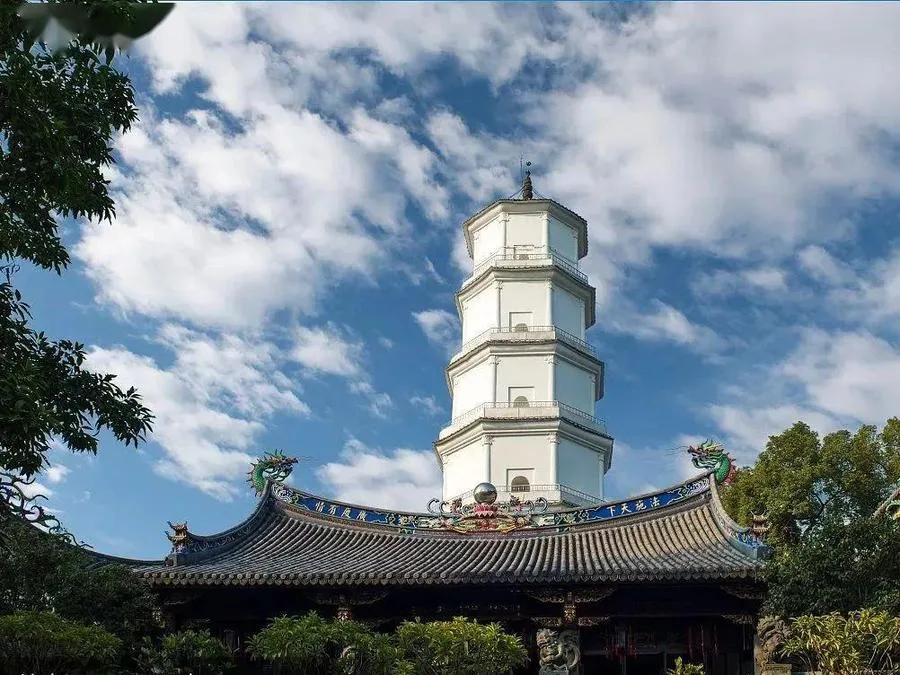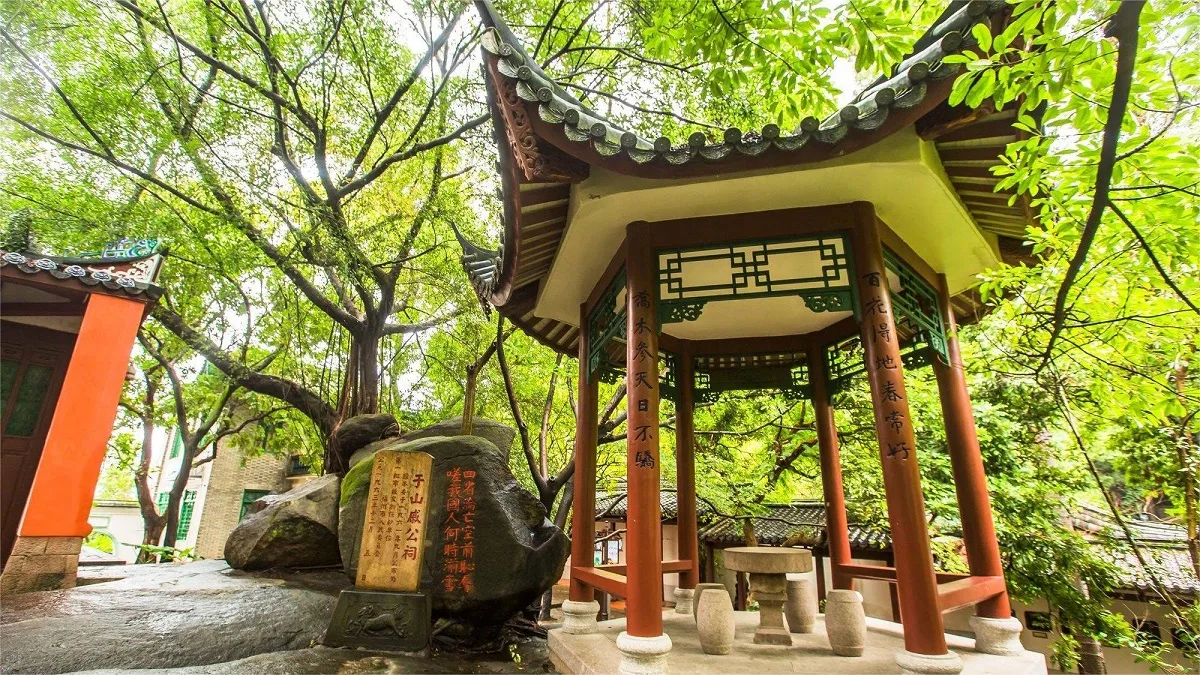Yushan Mountain (于山, Mount Yu, Yushan Hill), with an elevation of 52.2 meters, resembles a giant turtle and features its highest peak, Aoding Peak. This mountain is a sparkling gem embedded in the center of Fuzhou city. According to legend, it was named after the “Yuyue Clan” who settled there during the Warring States period. In the Han Dynasty, nine brothers of the He family from Linchuan practiced alchemy and sought immortality here, earning it the name Jiuxian Mountain. During the reign of Emperor Wu of Han, King Wuzhu of Minyue held a feast here on the ninth day of the ninth lunar month, thus it was also called Jiuri Mountain.
The mountain hosts numerous attractions such as the Dashidian Temple, Dingguang Pagoda, Qi Gong Shrine, and various cliffside inscriptions. Notably, the Dashidian Temple is one of the few temples in China that enshrines a male Guanyin. Yushan Mountain boasts 24 scenic spots, including the Jiuxian Temple. Presently, notable structures such as the Wanshou Temple, Qi Gong Shrine, Dashidian Temple, Dingguang Pagoda, and over a hundred cliff inscriptions from the Song Dynasty to the modern era still stand.
Ascending the mountain, visitors are greeted by towering trees and ancient banyans with sprawling roots, creating a magnificent and awe-inspiring sight.
Table of Contents
- Basic Information
- Location and Transportation
- Highlights of Yushan Mountain
- Vlog about Yushan Mountain
- Other Attractions in Fuzhou Urban Area
Basic Information
| Estimated Length of Tour | 2 hours |
| Ticket Price | Free |
| Opening Hours | 24 hours a day throughout the year |
| Telephone Number | 0086-0591-83306464 0086-0591-83355720 |
Location and Transportation
Yushan Mountain is located in the southeastern corner of Gulou District, in the center of Fuzhou City, Fujian Province. To get there, you can choose one of the following ways:
Bus: Tak ebus 8, 16, 86, 88, 97, 101, 103, 106, 122, 125, 133, 173, 303, 306, or K3 and get off at Yushan Stop (于山站).
Metro: The closest metro station to Yushan Mountain is Nanmendou (南门兜) on line 1 and line 2. After getting out of the station from Exit G1, you will be standing at the southwest corner of the mountain.
Highlights of Yushan Mountain
Baita Temple

Yushan Mountain is home to the renowned Baita Temple, also known as Dingguang Pagoda Temple. Originally built in 905 during the Tang Dynasty, it was founded by Wang Shenzhi, the Prince of Min, and later renamed “Wanshou Temple.” It was one of Fuzhou’s most famous temples during the Five Dynasties period. However, during the Jiajing period of the Ming Dynasty, many of its main halls were destroyed during the Japanese invasions. The existing structures were rebuilt during the Qing Dynasty, between the Daoguang and Guangxu reigns, and include three main halls: the Hall of Heavenly Kings, the Mahavira Hall, and the Fayutang Hall. Flanking the main halls are the Huafengtang Hall, the abbot’s quarters, guest rooms, and monk dormitories.
Fayutang Hall was built to commemorate a monk named Yishou, who performed a self-sacrifice for rain during the Later Liang period. According to legend, in 915, Fuzhou experienced a severe drought that prevented crops from growing. A wandering monk named Yishou arrived at Baita Temple to pray for rain. He piled wood into a tower in front of the temple and sat atop it, meditating and praying for rain. After three days, at the appointed time, he set the wood ablaze. As the flames rose, heavy rain began to fall, and Yishou miraculously emerged unharmed from the fire. In honor of Yishou’s sacrifice and miraculous act, the Fayutang Hall was built to memorialize him.
Baita (White Pagoda)

Originally named Bao’en Dingguang Duobao Pagoda, Baita was constructed in 904 during the Tang Dynasty by Wang Shenzhi, the Prince of Min, to honor his deceased mother. According to legend, during the construction, a radiant jewel was discovered at the site, leading to the pagoda’s name, Dingguang (“Radiant Light”). The original structure was a seven-story brick and wood pagoda, standing 66.7 meters tall. Each story featured intricately carved brackets, beams, and railings, and the walls and doors were adorned with paintings of Buddhist images.
In 1534, the pagoda was struck by lightning and burned down. It was rebuilt in 1548 during the Ming Dynasty, this time as a seven-story, octagonal brick pagoda, 41 meters tall. The exterior was coated with a layer of white plaster, giving it its common name, Baita or White Pagoda. Visitors can climb the spiral staircase inside the pagoda to the top, where they are rewarded with panoramic views of Fuzhou’s scenic landscape.
Qigong Shrine

Qigong Shrine was built in 1918 during the Republic of China era to commemorate General Qi Jiguang, who led troops to support Fujian in resisting Japanese pirates in 1562 during the Ming Dynasty. The shrine is situated on a rocky outcrop, covering an area of 4,100 square meters. The complex includes several picturesque spots such as Pingyuan Platform, Penglai Pavilion, Zuishi Pavilion, Sanshan Pavilion, Xicui Pavilion, and Bushan Retreat. These structures are scattered around the area, providing various viewpoints and serene spots for visitors to relax and enjoy the natural beauty.
Pingyuan Platform offers a broad vista of the surrounding area, while Penglai Pavilion and Sanshan Pavilion provide shaded resting spots with stunning views. Zuishi Pavilion, known for its inebriating scenery, and Xicui Pavilion, which seems to draw in the surrounding greenery, are perfect for those seeking tranquility. Bushan Retreat offers a quiet space for contemplation amidst nature.








